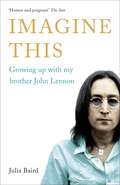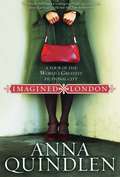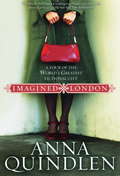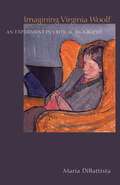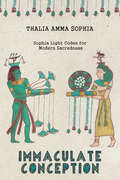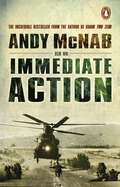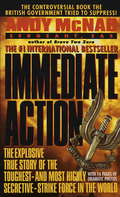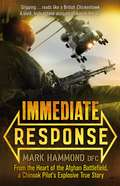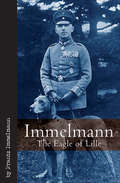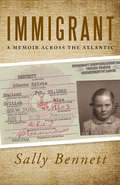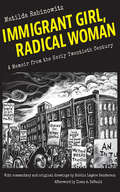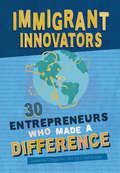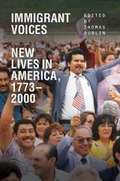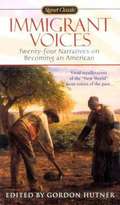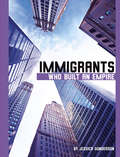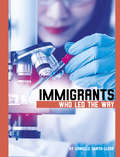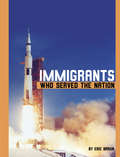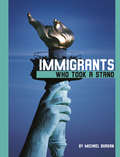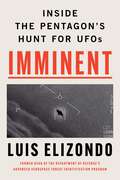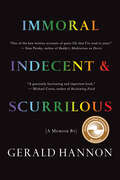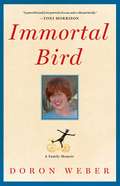- Table View
- List View
Imagine This: Growing Up With My Brother John Lennon
by Julia BairdUntil now, the true story of John Lennon's childhood has never been told. John's sister Julia has herself been on a personal journey that has made it possible only now to reveal the full extent of the pain and difficulties - as well as the happier times - living inside John Lennon's family brought.Julia reveals the various strong, self-willed and selfish women who surrounded John as he grew up. John was removed from his mother at the age of 5 to live with his Aunt Mimi, and here Julia shows for the first time the cruelty of this decision - to both mother and son, she sheds a new light on his upbringing with Mimi which is often at dramatic odds with the accepted tale. John's frequent visits to his mother and sisters gave him the liveliness, freedom and love he sought and allowed him to develop his musical talents. The tragic death of their mother, knocked down outside Aunt Mimi's house by a speeding car when John was 17, meant that life for him and his sisters would never be the same again.Poignant, raw and beautifully written, IMAGINE THIS casts John Lennon's life in a new light and reveals the source of his emotional fragility and musical genius. It is also one family's extraordinary story of how it dealt with fame and tragedy beyond all imagining.
Imagine This: Growing Up With My Brother John Lennon
by Julia Baird'Honest and poignant' THE SUNThe honest and revealing story of John Lennon's childhood by his sister Julia. Through her own personal journey, Julia reveals the battle between two strong, self-willed women - John's mother and his Aunt Mimi - to have custody of John in his early years. It was Aunt Mimi who finally won and removed John from his mother at the age of five. But as John grew up, he would frequently return home - spending time with his mother and half-sisters, Julia, Jackie and Ingrid, learning his love of music from his mother, and hanging out, playing guitar with his childhood friend Paul McCartney.Julia is candid about the sadness as well as the joy of their broken family life. She details the devestating loss of their mother Julia in a road accident - and describes the painful legacy for the entire family, especially John as he moves into a life of stratospheric fame with the Beatles.
Imagine Wanting Only This (Pantheon Graphic Library)
by Kristen RadtkeONE OF THE BEST BOOKS OF THE YEAR: Forbes • Lit Hub • Electric LitA gorgeous graphic memoir about loss, love, and confronting grief When Kristen Radtke was in college, the sudden death of a beloved uncle and the sight of an abandoned mining town after his funeral marked the beginning moments of a lifelong fascination with ruins and with people and places left behind. Over time, this fascination deepened until it triggered a journey around the world in search of ruined places. Now, in this genre-smashing graphic memoir, she leads us through deserted cities in the American Midwest, an Icelandic town buried in volcanic ash, islands in the Philippines, New York City, and the delicate passageways of the human heart. Along the way, we learn about her family and a rare genetic heart disease that has been passed down through generations, and revisit tragic events in America&’s past. A narrative that is at once narrative and factual, historical and personal, Radtke&’s stunning illustrations and piercing text never shy away from the big questions: Why are we here, and what will we leave behind? (With black-and-white illustrations throughout; part of the Pantheon Graphic Novel series)
Imagined London
by Anna QuindlenAnna Quindlen first visited London from a chair in her suburban Philadelphia home—in one of her beloved childhood mystery novels. She has been back to London countless times since, through the pages of books and in person, and now, in Imagined London, she takes her own readers on a tour of this greatest of literary cities. While New York, Paris, and Dublin are also vividly portrayed in fiction, it is London, Quindlen argues, that has always been the star, both because of the primacy of English literature and the specificity of city descriptions. She bases her view of the city on her own detailed literary map, tracking the footsteps of her favorite characters: the places where Evelyn Waugh's bright young things danced until dawn, or where Lydia Bennett eloped with the dastardly Wickham. In Imagined London, Quindlen walks through the city, moving within blocks from the great books of the 19th century to the detective novels of the 20th to the new modernist tradition of the 21st. With wit and charm, Imagined London gives this splendid city its full due in the landscape of the literary imagination. Praise for Imagined London: "Shows just how much a reading experience can enrich a physical journey." —New York Times Book Review "An elegant new work of nonfiction... People will be inspired by this book." —Ann Curry, Today "An affectionate, richly allusive tribute to the city." —Kirkus Reviews
Imagined London
by Anna QuindlenThe author writes about London's place in literature from the days of Chaucer to the present. She shares her impressions of the authors iinvolved both past and present and revives wonderful memories for lovers of the English novel.
Imagining Virginia Woolf: An Experiment in Critical Biography
by Maria DiBattistaWhere other works of literary criticism are absorbed with the question--How to read a book?--Imagining Virginia Woolf asks a slightly different but more intriguing one: how does one read an author? Maria DiBattista answers this by undertaking an experiment in critical biography. The subject of this work is not Virginia Woolf, the person who wrote the novels, criticism, letters, and famous diary, but a different being altogether, someone or something Maria DiBattista identifies as "the figment of the author." This is the Virginia Woolf who lives intermittently in the pages of her writings and in the imagination of her readers. Drawing on Woolf's own extensive remarks on the pleasures and perils of reading, DiBattista argues that reading Woolf, in fact reading any author, involves an encounter with this imaginative figment, whose distinct, stylistic traits combine to produce that beguiling phantom--the literary personality. DiBattista reveals a writer who possessed not a single personality, but a cluster of distinct, yet complementary identities: the Sibyl of Bloomsbury, the Author, the Critic, the World Writer, and the Adventurer, the last of which, DiBattista claims, unites them all. Imagining Virginia Woolf provides an original way of reading, one that captures with variety and subtlety the personality that exists only in Woolf's works and in the minds of her readers.
Immaculate Conception: Sophia Light Codes for Modern Sacredness
by Thalia Amma SophiaMiracles and phenomena of mystery between black magic, miracles and phenomena and religion. The first and last parts of Immaculate Conception tell the story of how a girl of the light becomes a real woman and let her wings unfurl. Through trials and tribulations, the reader is invited to reflect on testimonials of an initiate in a patriarchal society of dogma.At its core, this is a tale of a young woman in search of a life filled with love, spirituality, and the simple joys of existence, all while embracing her soul&’s destiny. Her story unfolds amidst the backdrop of stress, drama, &‘a-ha!&’ moments, and deep-rooted family traditions, guided by the steadfast presence of God&’s apostles.The second part is packed with rituals, channelled prayers, affirmations, and angelic protection invocations, to call on for a while or at various times. Special Key phrases have Sophia Codes that are lately coming to humanity for co-creating, healing, and expanding. With the support of Mother Mary and Archangels, Thalia Amma Sophia opens you to receive grace, brings you alignment and activation of your Higher Self; to neutralize the magnets pulling you into dysfunctional behaviour and past Life overlays!Prepare to awaken your innate ability to manifest desires and nurture creative ideas. Immaculate Conception extends an invitation to embark on a transformative journey where miracles, faith, and the boundless power of the human spirit intersect, promising the potential for grace, fulfilment, and profound transformation.
Immediate Action
by Andy McNabImmediate Action is a no-holds-barred account of an extraordinary life, from the day Andy McNab was found in a carrier bag on the steps of Guy's Hospital to the day he went to fight in the Gulf War.As a delinquent youth he kicked against society. As a young soldier he waged war against the IRA in the streets and fields of South Armagh. As a member of 22 SAS Regiment he was at the centre of covert operations for nine years - on five continents.Recounting with grim humour and in riveting, often horrifying, detail his activities in the world's most highly trained and efficient Special Forces unit, McNab sweeps us into a world of surveillance and intelligence-gathering, counter-terrorism and hostage rescue.There are casualties: the best men are so often the first to be killed, because they are in front.By turns chilling, astonishing, violent, funny and moving, this blistering first-hand account of life at the forward edge of battle confirms Andy McNab's standing in the front rank of writers on modern war.
Immediate Action
by Andy McnabImmediate Action is a no-holds-barred account of an extraordinary life, from the day Andy McNab was found in a carrier bag on the steps of Guy's Hospital to the day he went to fight in the Gulf War. As a delinquent youth he kicked against society. As a young soldier he waged war against the IRA in the streets and fields of South Armagh. As a member of 22 SAS Regiment he was at the centre of covert operations for nine years - on five continents. Recounting with grim humour and in riveting, often horrifying, detail his activities in the world's most highly trained and efficient Special Forces unit, McNab sweeps us into a world of surveillance and intelligence-gathering, counter-terrorism and hostage rescue. There are casualties: the best men are so often the first to be killed, because they are in front. By turns chilling, astonishing, violent, funny and moving, this blistering first-hand account of life at the forward edge of battle confirms Andy McNab's standing in the front rank of writers on modern war.
Immediate Response: Original Edition
by Mark Hammond2006 in Helmand saw British forces engaged in the most ferocious fighting since the Korean War. For much of the time they were hanging on by their fingertips, holed up in remote platoon houses, outnumbered, facing relentless assault and nearly overwhelmed. Only the Chinooks kept them in the game. But that meant their crews putting down in hot LZs, exposing their aircraft to withering attack from an enemy for whom downing one of the big helos would be the ultimate prize.They had been lucky. So far. Then they launched their biggest operation yet: a complicated, high-risk airborne assault that launched a fleet of heavily armed helicopters into the Afghan Heart of Darkness. And then a report came over the net that one of the Chinooks was down . . .In Immediate Response, Major Mark Hammond, a Royal Marine flying with the RAF, tells the gripping inside story of the Chinook squadrons' war for the first time. It's a visceral, unputdownable combination of hi-tech and old-fashioned grit; an action-packed story shot through with a mix of aviation fuel and cordite ...
Immelmann: The Eagle of Lille (Vintage Aviation Library)
by Frantz ImmelmannA biography of one of Germany&’s pioneers in aerial combat: &“a great read&” (Internet Modeler). Max Immelmann was born in Dresden, the son of a container factory owner. When World War I started, Immelmann was recalled to active service, transferred to the Luftstreitkäfte, and sent for pilot training in November 1914. He was on his way to becoming a legendary flying ace. Initially stationed in northern France as a reconnaissance aviator, he was shot down by a French pilot but managed to land safely behind German lines. He was decorated with the Iron Cross, Second Class for preserving his aircraft. Later in 1915, he became one of the first German fighter pilots, quickly building an impressive score of victories as he became known as The Eagle of Lille, Der Adler von Lille. Known for the aerial combat maneuver that bears his name; for the use of a machine gun synchronized to fire forward through the propeller arc; and for his association with the Fokker Eindecker, Germany&’s first fighter aircraft, Immelmann was the first pilot to be awarded the Pour le Mérite, Germany&’s highest military honor—which became colloquially known as the &“Blue Max&” in the German Air Service. Along with Oswald Boelcke and other pilots, Immelmann was one of the main instigators of the Fokker Scourge, which inflicted heavy losses upon British and French aircrews during 1915. He was credited with fifteen victories—the final one coming on March 30, 1916. This Casemate edition of Max Immelmann&’s biography does not change a word from the original 1930 edition, but for the first time, reworks the original type and page layout to provide a beautiful and highly readable new treatment to this classic of aviation literature.
Immigrant
by Sally BennettA Memoir Across the AtlanticI was born in 1932 in Yorkshire to parents who had survived World War I and had seen England change from an agricultural to an industrial country. A visiting American engineer changed our lives when he asked my mother to leave my father and accompany him to Spain, which she did, taking me with her. When World War II changed Europe forever, my English mother, my sister, and I fled to America, leaving my stepfather behind to work for the OSS and to begin an affair with a Spanish spy whom he later married. The war over, my mother, sister, and I returned first to Europe then back to America, where my mother struggled to put a life together for herself and her two daughters.
Immigrant Architect: Rafael Guastavino And The American Dream
by Berta de Miguel Kent DieboltThe Spanish architects Rafael Guastavino Sr. and his son, Rafael Guastavino Jr., designed more than one thousand iconic spaces across New York City and the United States, such as the New York City Hall Subway Station (still a tourist destination though no longer active), the Manhattan Federal Reserve Bank, the Nebraska State Capitol, the Great Hall of Ellis Island, the Oyster bar at Grand Central Terminal in New York, the Elephant House at the Bronx Zoo, the soaring tiled vaults under the Queensboro Bridge, the central dome of the Cathedral Church of St. John the Divine, and the Boston Public Library. Written in the voice of the son, who was eight years old in 1881 when he immigrated to America with his father, this is their story. Rafael Guastavino Sr. was 39 when he left a successful career as an architect in Barcelona. American cities—densely packed and built largely of wood—were experiencing horrific fires, and Guastavino had the solution: The soaring interior spaces created by his tiled vaults and domes made buildings sturdier, fireproof, and beautiful. What he didn’t have was fluent English. Unable to win design commissions, he transferred control of the company to his American-educated son, whose subsequent half-century of inspired design work resulted in major contributions to the built environment of America. Immigrant Architect is an introduction to architectural concepts and a timely reminder of immigrant contributions to America. The book includes four route maps for visiting Guastavino-designed spaces in New York City: uptown, midtown, downtown, and Prospect Park.
Immigrant Girl, Radical Woman: A Memoir from the Early Twentieth Century
by Matilda RabinowitzMatilda Rabinowitz’s illustrated memoir challenges assumptions about the lives of early twentieth-century women. In Immigrant Girl, Radical Woman, Rabinowitz describes the ways in which she and her contemporaries rejected the intellectual and social restrictions imposed on women as they sought political and economic equality in the first half of the twentieth century. Rabinowitz devoted her labor and commitment to the notion that women should feel entitled to independence, equal rights, equal pay, and sexual and personal autonomy.Rabinowitz (1887–1963) immigrated to the United States from Ukraine at the age of thirteen. Radicalized by her experience in sweatshops, she became an organizer for the Industrial Workers of the World from 1912 to 1917 before choosing single motherhood in 1918. "Big Bill" Haywood once wrote, "a book could be written about Matilda," but her memoir was intended as a private story for her grandchildren, Robbin Légère Henderson among them. Henderson’s black-and white-scratchboard drawings illustrate Rabinowitz’s life in the Pale of Settlement, the journey to America, political awakening and work as an organizer for the IWW, a turbulent romance, and her struggle to support herself and her child.
Immigrant Innovators: 30 Entrepreneurs Who Made a Difference
by Samantha ChagollanAn inspiring children&’s biography collection, Immigrant Innovators highlights the stories of 30 immigrant entrepreneurs who have made it big in America. Geared toward readers ages 8–12, the book features people from around the world who played a major role in establishing global companies and products. These entrepreneurs come from more than 25 countries and have been successful in a wide range of fields, from energy bars (KIND), yogurt (Chobani), and restaurant chains (Panda Express), to dominant industry players like YouTube and Tesla. The book includes full-page illustrated portraits of each entrepreneur as well as colorful infographics throughout.Immigrant Innovators is a celebration of the immigrant experience—both the triumphs and the challenges—and an important reminder of the strength that comes from a broad and diverse population. Included, among others, are: Ayah Bdeir, Lebanon, littleBitsRihanna, Barbados, Fenty BeautyMarcus Samuelsson, Ethiopia, ChefHamdi Ulukaya, Turkey, ChobaniMax Levchin, Ukraine, PayPalMike Krieger, Brazil, Instagram Daniel Lubetzky, Mexico, KIND SnacksAdi Tatarko and Alon Cohen, Israel, HouzzLuis von Ahn, Guatemala, DuolingoPierre Omidyar, France, eBayLaura Behrens Wu, Germany, Shippo José Andrés, Spain, Founder of World Central Kitchen Also includes infographics like: Pioneering EntrepreneursKids of ImmigrantsImmigrant Entrepreneurs: By the NumbersWhat Kind of Entrepreneur Are You?
Immigrant Voices: New Lives in America, 1773-2000
by Thomas DublinA classroom staple, Immigrant Voices: New Lives in America, 1773-2000 has been updated with writings that reflect trends in immigration to the United States through the turn of the twenty-first century. New chapters include a selection of letters from Irish immigrants fleeing the famine of the 1840s, writings from an immigrant who escaped the civil war in Liberia during the 1980s, and letters that crossed the U.S.-Mexico border during the late 1980s and early '90s. With each addition editor Thomas Dublin has kept to his original goals, which was to show the commonalities of the U.S. immigrant experience across lines of gender, nation of origin, race, and even time.
Immigrant Voices: Twenty-four Narratives on Becoming an American
by Gordon HutnerThis wonderful anthology recreates the past from the voices of those who struggled to adapt to the "new world. " Facing such adversity as assimilation, prejudice, poverty, homesickness, and identity, these newcomers were able to persevere and their inspiring stories are full of hope, faith, and conviction. Gathering together narratives from the eighteenth to the twentieth century, this one-of-a-kind collection provides both a historical and uniquely personal perspective on the struggles and successes of immigrants--and illuminates for readers the difficult, rewarding experience of becoming an American.
Immigrants Who Built an Empire (Immigrants Who Dared)
by Jessica GundersonSome of the most important American industries and ideas stem from people born outside the United States. Immigrants have had major influence on daily life in the United States, from how Americans search the internet and use their phones to the clothes they wear and the buildings in which they live. Meet 25 immigrants who built empires as artists, scientists, writers, musicians, inventors, and entrepreneurs.
Immigrants Who Led the Way (Immigrants Who Dared)
by Danielle Smith-LleraSome of the most important American products and ideas have been developed by people born outside the United States. They have influenced every part of U.S. culture, from what people wear and drive to how they stay healthy, how they communicate with each other, and what they do for fun. Meet 25 immigrants who have led the way with life-saving inventions, by opening up sports to women and people of color, and so much more.
Immigrants Who Served the Nation (Immigrants Who Dared)
by Eric BraunSome of the most important roles in American life have been filled by people born outside the United States. Immigrants have served in the military since the Civil War. Some immigrants have made fortunes and given them away—to create libraries, fund after-school programs, and protect citizens’ civil rights. Still others have held political office or served our nation as ambassadors or—literally—rocket scientists. Here are 25 immigrants who have served our nation in these and other important ways.
Immigrants Who Took a Stand (Immigrants Who Dared)
by Michael BurganSome of the most important changes in American culture have been driven by people born outside the United States. Immigrants may come as refugees, as workers, or as students. They may come as children or as adults. Once here, many speak out for the rights of others or try to build a better country by working within the government. Some give money to good causes. Others point out problems that need to be fixed. Still others create art and music that gives voice to the downtrodden. Here are 25 immigrants who have made a difference by taking a stand.
Imminent: Inside the Pentagon's Hunt for UFOs
by Luis ElizondoThe former head of the Pentagon program responsible for the investigation of UFOs—now known as unidentified anomalous phenomena (UAP)—reveals long-hidden secrets with profound implications for not only national security but our understanding of the universe. <P><P> Luis “Lue” Elizondo is a former senior intelligence official and special agent who was recruited into strange and highly sensitive US government program to investigate UAP. To accomplish his mission, Elizondo had to rely on decades of experience gained working some of America’s most classified programs. Even then, he was not prepared for what he would learn, including the truth about the government’s long shadowy involvement in UAP investigations, and the lengths officials would take to keep it a secret. <P><P> For years, Elizondo and his colleagues found themselves on the front lines of what may be the greatest mystery and cover-up in history. Unidentified craft that seem to defy our knowledge of physics**—within air, water, and space—**have been operating with complete impunity since at least World War II. The military, the CIA, and even past presidents have known the truth that humanity is, in fact, not the only intelligent life in the universe. The nonhuman intelligence controlling these UAP are actively conducting surveillance on our most sensitive military installations, and have interfered with ongoing military and nuclear operations. US service members and intelligence officers who have encountered UAP have sustained serious medical injuries. And all of this is happening worldwide. <P><P> The stakes could not be higher. Imminent is a first-hand, revelatory account inside the Pentagon’s most closely guarded secret and a call to action to confront humanity’s greatest existential questions. <p> <b>New York Times Bestseller</b>
Immoral, Indecent, and Scurrilous: The Making of an Unrepentant Sex Radical
by Gerald Hannon“At least by reputation, I am a sex radical: gay activist dating back to the Cretaceous, defender of pedophiles, defender of (and participant in) sex work, sometime porn actor and maker, shameless voyeur (no window is safe if my binoculars are at hand), perpetual sour-puss on the subject of gay marriage. I came of age in the 1960s and ’70s, an era when most of those character traits and activities would have been seen as illegal at worst and shameless at best. Some still are. Others — gay marriage, for example — have switched sides, transitioning from what many people thought of as an unthinkable and illegal travesty to a ritual celebrated in a growing number of jurisdictions, Canada included.” When 18-year-old Gerald Hannon left the small pulp mill town of Marathon, Ontario to attend the University of Toronto, he never would have predicted he’d become part of LGBTQ2S+ history. Almost sixty years later, he reflects on the major moments in his career as a journalist and LGBTQ2S+ activist. From the charges of transmitting immoral, indecent, and scurrilous literature laid against him and his colleagues at The Body Politic to his dismissal from his teaching post at Ryerson University for being a sex worker, this memoir candidly chronicles Hannon’s life as an unrepentant sex radical.
Immortal Bird
by Doron Weber"Maybe I've finally beaten this thing, maybe three years' struggle will not have been in vain. Maybe this is finally over . . ." --from Damon's blog, May 2004 A FAMILY' S LOVE lies at the heart of this gifted boy's fight to survive. Born with a congenital heart defect that required surgery when he was a baby, Damon Weber lives a big life with spirit and independence that have always been a source of pride to his parents, Doron and Shealagh. But when Damon is diagnosed with a new illness as a teenager, his triumphant coming-of-age tale turns into a darker and more dramatic quest: his family's race against time and a flawed heath care system.Immortal Bird is a searing account of a father's struggle to save his remarkable son, a story of a young boy's passion for life, and a tribute to his family's love. It is also a story of the perils of modern medicine and the redemptive power of art in the face of the unthinkable.
